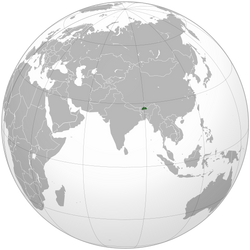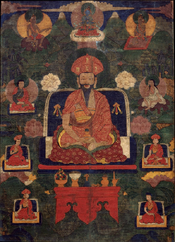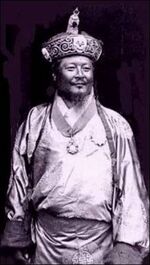| Kingdom of Bhutan འབྲུག་རྒྱལ་ཁབ་ | |||||
|---|---|---|---|---|---|
| |||||

| |||||
| Capital | |||||
| Languages | |||||
| Demonym |
Bhutanese | ||||
| Currency | |||||
| Establishment | |||||
|
-Formation |
early 17th century | ||||
|
December 17, 1907 | |||||
| GDP (PPP) | |||||
| -Total |
$4.287 billion (2011) | ||||
| -Per capita |
$6,112 (2011) | ||||
| GDP (nominal) | |||||
| -Total |
$1.488 billion (2011) | ||||
| -Per capita |
$2121 (2011) | ||||
| v · d · e | |||||
Bhutan (Dzongkha: འབྲུག་ཡུལ་; Wylie transliteration: ʼbrug-yul), officially the Kingdom of Bhutan (Dzongkha: འབྲུག་རྒྱལ་ཁབ; Wylie: Brug Rgyal-khab), is a landlocked state located in Southern Asia at the eastern edge of the Himalayas. It is bordered by the People's Republic of China to the north, and India to the east, south, and west. Along with nearby Nepal, it is one of the only few countries that has been independent throughout its history.
History[]

Shabdrung Ngawang Namgyal
Bhutan's early history is imbued in mythology and remains obscure. Knowledge of prehistoric Bhutan has not yet emerged from archaeological study, but ancient artifacts such as stone tools, weapons, structures, and megaliths provide evidence that civilization may have thrived in the country's boundaries as early as 2000 BC. Not much is known about the country until the introduction of Buddhism in the 9th century, when religious persecution in Tibet forced many monks to flee. There is some speculation that Bhutan was part of the Kamarupa Kingdom and Tibetan Empire from the 7th to 9th centuries, but not much evidence has been discovered that supports this belief. A central government did not exist in Bhutan around the arrival of Buddhism, but instead, small independent kingdoms ruled by debs (kings) began to develop during this time period, the most prominent of which being the Kingdom of Bumthang. A theocratic government consolidating the many kingdoms was established by an expatriate monk, Ngawang Namgyal (1594–1651), who came to Bhutan in 1616 for freedom from the domination of the Gelug school in Lhasa. Armies from Tibet attacked multiple times during Ngawang Namgyal's lifetime in hopes of suppressing his popularity before it spread too far. Each invasion was thwarted, and the Drukpa subsect developed a strong presence in Bhutan, leaving Ngawang Namgyal supreme. In recognition of his acquired power, missions were sent to the area from Cooch Behar, Nepal, and Ladakh. However, Bhutan's troubles were not yet over. A joint Mongol-Tibetan force intent on eliminating Nyingmapa refugees who fled to Bhutan, Nepal, and Sikkim invaded the area in 1643. However, this and another invasion by the Tibetans in 1647 were both unsuccessful.

Ugyen Wangchuck, the first King of Bhutan
The Bhutanese invaded and conquered the neighboring kingdom of Cooch Behar in the 18th century. In 1772, the kingdom prompted the British East India Company to aid in ousting the Bhutanese rule and later attacking Bhutan itself in 1774. A peace treaty was signed that called for Bhutan to retreat to its pre-1730 borders, but border skirmishes with the British continued for the next hundred years. Such skirmishes eventually led to the Duar War (1864–1865), a confrontation for control of the Bengal Duars. After Bhutan's defeat, the Treaty of Sinchula (1865) was signed by the British East India Company and Bhutan, thus ending all hostilities between British India and the country. Several years later, in 1907, Ugyen Wangchuck (1862–1926) was unanimously chosen as the hereditary king of Bhutan by an assembly consisting of Buddhist monks, government officials, and the heads of important families. The government of Britain immediately recognized the new monarchy, and in 1910 Bhutan signed the Treaty of Punakha (1910), which allowed the British to control Bhutanese foreign affairs and meant Bhutan was treated as an Indian princely state. After the Dominion of India became independent from the United Kingdom in 1947, Bhutan was one of the first to recognize India's independence. On August 8, 1949, Bhutan signed a treaty similar to the Treaty of Punakha granting India control of Bhutan's foreign affairs. King Jigme Dorji Wangchuck (1929–1972) established his country's legislature, a 130-member National Assembly, in 1953 to introduce a more democratic form of government. This was followed by the founding of a Royal Advisory Council in 1965 and a Cabinet in 1968. Bhutan was admitted to the United Nations in 1971, having held observer status for three years. Several political reforms and modernization attempts were then made in the country under Jigme Singye Wangchuck (1955–), Jigme Dorji Wangchuck's successor. A new constitution was recently adopted in 2006, and Jigme Khesar Namgyel Wangchuck (1980–) was crowned King in 2008. The country is currently a constitutional monarchy led by the king and Prime Minister Tshering Tobgay (1965–).
Economy[]
- Main article: Economy of Bhutan

Bhutanese people harvesting crops
Although the economy of Bhutan is one of the world's smallest, it has grown quickly in recent years, having increased by eight percent in 2005 and fourteen percent in 2006. Bhutan had the second fastest growing economy in the world in 2007, with an economic growth rate of 22.4 percent annually. This rate was largely attributable to the establishment of the gigantic hydroelectricity joint project between India and Bhutan in the town of Tala. As of March 2006, the per capita income in the country was US$1,321.
Bhutan's economy is heavily based on agriculture, forestry, tourism, and the sale of hydroelectric power to its neighbor India. Over 80 percent of the population works in agriculture. Agrarian practices consist primarily of subsistence agriculture and animal husbandry. Weaving and the production of religious art for home altars, as well as other handicrafts, make up a small cottage industry. Due to Bhutan's hilly to mountainous landscape, the construction of roads and other infrastructure is difficult and many times expensive. This, and a lack of access to the sea, have meant that Bhutan has been unable to participate in very much international trade. Bhutan does not currently have any railways, though Indian Railways intends to link the southern part of the country to its network per an agreement signed in January 2005. Bhutan and India signed a free trade agreement in 2008, which, among other provisions, allowed Bhutanese imports and exports from markets to be sold in India without tariffs. The country did have trade relations with the Tibet Autonomous Region until it closed its border with China in 1960 due to an influx of refugees from the region.
Industry is an emerging sector of Bhutan's economy, and even though most manufacturing is done in the cottage industry, the establishment of larger industries is being encouraged and some industries such as cement, steel, and ferroalloy have been set up. The country is often reliant on Indian contract labor for development projects such as road construction. Agricultural products from Bhutan include apples, barley, buckwheat, chilies, citrus, dairy products, maize, rice, and root crops at lower elevations. Products from the industry sector include alcoholic beverages, calcium carbide, cement, processed fruits, and wood.
Each year, incomes of over 100,000 ngultrums are taxed, but only a small number of wage and salary earners qualify. In 2003 Bhutan's inflation rate was estimated at about 3 percent. The country has a gross domestic product (GDP) purchasing power parity of around US$2.913 billion, making it the 162nd largest economy in the world. Per capita income is about US$1400, ranked 124th in the world. Government revenues amount to about $272 million, though expenditures make up $350 million. However, approximately 60 percent of the budget expenditure is financed by the Indian Ministry of External Affairs. The country's exports, mainly cardamom, cement, electricity, fruit, gypsum, handicrafts, precious stones, spices, and timber, estimated €128 million in 2000. Imports, however, were about €164 million, causing trade deficit. Many of the items imported by Bhutan include fabrics, fuel and lubricants, grain, machinery, and vehicles. India is Bhutan's main export partner, accounting for nearly 58.6 percent of its exported goods. Hong Kong and Bangladesh are other top export partners, respectively accounting for 30.1 and 7.3 percent of Bhutanese exports. As its border with Tibet is closed, trade between Bhutan and China is now nearly non-existent. Bhutan's import partners include India, Japan, and Sweden.
Numismatics[]

A Bhutanese ngultrum note from 1986
In spite of its situation near India and China, two countries with long histories of coin production, Bhutan does not have much of a numismatic history. Bhutan did not start to use precious metals as currency until the late 16th century. At some point, coins from neighboring countries, including Assam, Cooch Behar, Nepal, and Tibet began circulating in the country, especially those of Cooch Behar. These coins, denominated in rupees, were used until the mint's closure in 1789. In 1790, Bhutan introduced its own rupee, initially divided into 64 paisa. Earlier coins of the currency were very similar in design to those of Cooch Behar. The Indian rupee, at the time divided into 16 anna, began to circulate alongside Bhutan's currency in 1907, sharing a fixed exchange rate with it. The Indian currency was decimalized into 100 naye paise in 1957, and Bhutan's currency eventually followed suit in 1966. The Bhutanese rupee continued to circulate until the ngultrum, the current currency of Bhutan, was introduced in 1974. The first banknotes attributable to the country were printed in 1974 by the Royal Government of Bhutan. Since its creation, the ngultrum has been subdivided into 100 chhertum (or chetrums) and has maintained its fixed exchange rate to the Indian rupee, which also continues to circulate in Bhutan.
| Code | Currency Name | Dates | Conversion | Divisions | |||
|---|---|---|---|---|---|---|---|
| Bhutanese rupee |
|
Initially: 64 Paisa = 1 Rupee; After 1966: 100 Paisa = 1 Rupee | |||||
| INR | Indian rupee |
|
Initially: 16 Anna = 1 Rupee; After 1957: 100 Paisa = 1 Rupee | ||||
| BTN | Bhutanese ngultrum |
|
1 Bhutanese rupee = 1 BTN | 100 Chhertum = 1 Ngultrum |
References[]
| Currency Wiki has 6 images related to Bhutan. |
Bhutan on the English Wikipedia
Bhutanese rupee on the English Wikipedia
History of Bhutan on the English Wikipedia
- Coinage in Bhutan During the 19th and 20th Centuries
| Bhutan topics | ||
|---|---|---|
| History | pre-17th century • Kingdom of Bhutan (17th century-present) | 
|
| Currencies | Coins of the Koch Kingdom (?-1789) • Bhutanese rupee (1790-1974) • Indian rupee (1907-present) • Bhutanese ngultrum (1974-present) | |
| Economy | Economy of Bhutan • Royal Monetary Authority of Bhutan | |
| Asia | |
|---|---|
| Countries | Afghanistan • Armenia* • Bahrain • Bangladesh • Bhutan • Brunei • Cambodia • China • Cyprus* • Georgia* • East Timor* (Timor-Leste) • India • Indonesia* • Iran • Iraq • Israel • Japan • Jordan • Kazakhstan • Kuwait • Kyrgyzstan • Laos • Lebanon • Malaysia • Maldives • Mongolia • Myanmar (Burma) • Nepal • North Korea • Oman • Pakistan • Philippines • Qatar • Russia* • Saudi Arabia • Singapore • South Korea • Sri Lanka • Syria • Tajikistan • Thailand • Turkey* • Turkmenistan • United Arab Emirates • Uzbekistan • Vietnam • Yemen |
| Partially-recognized states | Abkhazia • Nagorno-Karabakh • Northern Cyprus • Palestine • South Ossetia • Taiwan |
| Non-sovereign territories | Akrotiri and Dhekelia • British Indian Ocean Territory • Christmas Island • Cocos (Keeling) Islands • Hong Kong • Macau |


